Tetramorium kelleri
| Tetramorium kelleri | |
|---|---|

| |
| Scientific classification | |
| Kingdom: | Animalia |
| Phylum: | Arthropoda |
| Class: | Insecta |
| Order: | Hymenoptera |
| Family: | Formicidae |
| Subfamily: | Myrmicinae |
| Tribe: | Crematogastrini |
| Genus: | Tetramorium |
| Species: | T. kelleri |
| Binomial name | |
| Tetramorium kelleri Forel, 1887 | |
A very common species with a relatively broad distribution range in Madagascar. Tetramorium kelleri is mainly encountered in northern and western Madagascar, and on several islands including Nosy Be, Nosy Mangabe, and Nosy Ngontsy. Interestingly, most localities are in relatively close proximity to the ocean since no material was collected more than 50 km inland. One aspect that deserves attention, however, is the type locality, the Ivondro River, which is relatively far from the currently known distribution range mentioned above. The area around the Ivondro River in eastern Madagascar was intensively sampled by the Malagasy ant inventory (see Fisher, 2005), but no additional T. kelleri material was found. Indeed, not a single modern specimen is known from eastern Madagascar south of Nosy Mangabe. One possible explanation could be that the species was present in the area over 120 years ago, but did not survive until the present day. This is surprising, though, since the species is comparatively flexible in its habitat requirements. It was collected from rainforest, littoral rainforest, tropical dry forest, and secondary forest at elevations from 5 to 780 m, although mostly at the lower range. (Hita Garcia and Fisher 20(Hita Garcia and Fisher 2012)
Identification
A member of the Tetramorium kelleri species group.
Tetramorium kelleri differs from Tetramorium ankarana by the character combination of: large eyes (OI 24 - 26); relatively shorter antennal scapes (SI 89 - 99); and extremely long propodeal spines (PSLI 49 - 68). Despite being a very common species with a relatively broad distribution range, which includes several islands, T. kelleri remains remarkably invariable. Some minor variation in colouration is observed ranging from whitish-yellowish to brown, although we do not think it significant for species diagnostics. In general, as already stated by Bolton (1979), it is a highly conspicuous and easily recognisable Malagasy ant species. (Hita Garcia and Fisher 2012)
Distribution
Latitudinal Distribution Pattern
Latitudinal Range: 16.925° to -15.41416667°.
| North Temperate |
North Subtropical |
Tropical | South Subtropical |
South Temperate |
- Source: AntMaps
Distribution based on Regional Taxon Lists
Malagasy Region: Madagascar (type locality), Mayotte.
Distribution based on AntMaps
Distribution based on AntWeb specimens
Check data from AntWeb
Countries Occupied
| Number of countries occupied by this species based on AntWiki Regional Taxon Lists. In general, fewer countries occupied indicates a narrower range, while more countries indicates a more widespread species. |

|
Estimated Abundance
| Relative abundance based on number of AntMaps records per species (this species within the purple bar). Fewer records (to the left) indicates a less abundant/encountered species while more records (to the right) indicates more abundant/encountered species. |

|
Biology
Castes
Additional images can be found at the Tetramorium kelleri Category page
Worker
Images from AntWeb
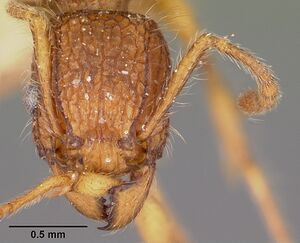   
| |
| Worker. Specimen code casent0101293. Photographer April Nobile, uploaded by California Academy of Sciences. | Owned by MHNG, Geneva, Switzerland. |
   
| |
| Type of Tetramorium kelleri. Worker. Specimen code casent0104607. Photographer April Nobile, uploaded by California Academy of Sciences. | Owned by ZMHB, Berlin, Germany. |
   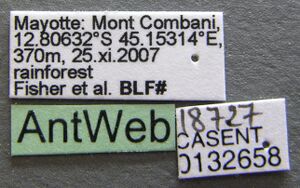
| |
| Worker. Specimen code casent0132658. Photographer Erin Prado, uploaded by California Academy of Sciences. | Owned by CAS, San Francisco, CA, USA. |
  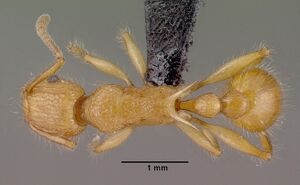 
| |
| Worker. Specimen code casent0467063. Photographer April Nobile, uploaded by California Academy of Sciences. | Owned by CAS, San Francisco, CA, USA. |
Queen
Images from AntWeb
    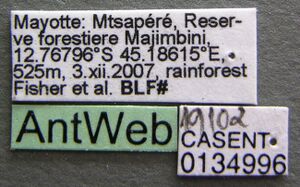
| |
| Queen (alate/dealate). Specimen code casent0134996. Photographer Erin Prado, uploaded by California Academy of Sciences. | Owned by CAS, San Francisco, CA, USA. |
  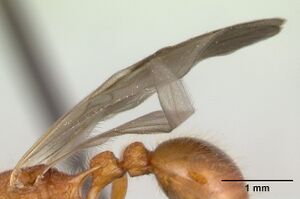  
| |
| Queen (alate/dealate). Specimen code casent0134890. Photographer Erin Prado, uploaded by California Academy of Sciences. | Owned by CAS, San Francisco, CA, USA. |
Male
Images from AntWeb
     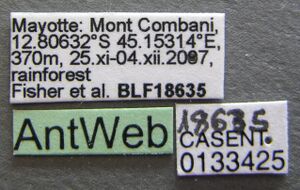
| |
| Male (alate). Specimen code casent0133425. Photographer Erin Prado, uploaded by California Academy of Sciences. | Owned by CAS, San Francisco, CA, USA. |
Nomenclature
The following information is derived from Barry Bolton's Online Catalogue of the Ants of the World.
- kelleri. Tetramorium (Xiphomyrmex) kelleri Forel, 1887: 385 (w.) MADAGASCAR. See also: Bolton, 1979: 145; Hita Garcia & Fisher, 2012: 11.
Unless otherwise noted the text for the remainder of this section is reported from the publication that includes the original description.
Description
Worker
Hita Garcia and Fisher (2012) - HL 0.98 - 1.11 (1.03); HW 0.85 - 0.97 (0.90); SL 0.79 - 0.90 (0.85); EL 0.21 - 0.24 (0.22); PH 0.45 - 0.58 (0.52); PW 0.66 - 0.80 (0.73); WL 1.29 - 1.48 (1.37); PSL 0.50 - 0.73 (0.59); PTL 0.36 - 0.44 (0.40); PTH 0.37 - 0.44 (0.40); PTW 0.29 - 0.36 (0.33); PPL 0.32 - 0.37 (0.34); PPH 0.38 - 0.44 (0.40); PPW 0.37 - 0.43 (0.40); CI 84 - 89 (87); SI 89 - 99 (94); OI 24 - 26 (25); DMI 50 - 59 (53); LMI 35 - 40 (38); PSLI 49 - 68 (57); PeNI 41 - 50 (46); LPeI 95 - 102 (99); DPeI 79 - 86 (83); PpNI 49 - 59 (55); LPpI 81 - 90 (86); DPpI 109 - 124 (117); PPI 114 - 126 (121) (25 measured).
Head much longer than wide (CI 84 - 89); posterior head margin very weakly concave. Anterior clypeal margin medially impressed, often weakly so. Frontal carinae strongly developed, approaching corners of posterior head margin. Antennal scrobes well-developed, moderately deep, narrow, and without defined posterior margin; ventral margin moderately defined. Antennal scapes moderately long to long, reaching posterior head margin (SI 89 - 99). Eyes large (OI 24 - 26). Mesosomal outline in profile flat to weakly convex, very weakly marginate from lateral to dorsal mesosoma, sides rounding smoothly onto the dorsum; promesonotal suture and metanotal groove absent; mesosoma comparatively stout and high (LMI 35 - 40). Propodeal spines extremely long, spinose and acute (PSLI 49 - 68); propodeal lobes short, triangular, and rounded, sometimes weakly acute. Petiolar node in profile clublike with fairly rounded margins, ranging from weakly longer than high to weakly higher than long (LPeI 95 - 102), anterodorsal margin situated lower than posterodorsal margin, dorsum noticeably convex; node in dorsal view approximately 1.2 to 1.3 times longer than wide (DPeI 79 - 86). Postpetiole in profile globular to subglobular, approximately 1.1 to 1.2 times higher than long (LPpI 81 - 90); in dorsal view around 1.1 to 1.3 times wider than long (DPpI 109 - 124). Postpetiole in profile appearing less voluminous than petiolar node, in dorsal view 1.1 to 1.3 times wider than petiolar node (PPI 114 - 126). Mandibles strongly striate; clypeus longitudinally rugose/rugulose, median ruga always present and distinct, remaining rugae/rugulae weaker and variably developed; cephalic dorsum between frontal carinae reticulate-rugose to longitudinally rugose, posteriorly more reticulate-rugose and anteriorly more longitudinally rugose; lateral and ventral head mostly reticulate-rugose. Mesosoma dorsally mainly reticulate-rugose, laterally reticulate-rugose to longitudinally rugose. Forecoxae usually with weak to moderately developed longitudinal rugae/rugulae, sometimes reduced. Waist segments mainly longitudinally rugulose, less reticulate-rugulose. First gastral tergite unsculptured, smooth, and shining. Whole body covered with numerous, very long, fine standing hairs. Body of uniform whitish-yellowish to brown, mostly yellowish to orange-brown.
Type Material
Syntype workers, MADAGASCAR, Toamasina, Ivondro, pr. Tamatave (C. Keller). (The Natural History Museum: CASENT0102339; Naturhistorisches Museum, Basel: CASENT0101138; Museum of Comparative Zoology: CASENT0247309; CASENT0247310; MHNG: CASENT0101293; CASENT0101294; CASENT0101938; National Museum of Natural History) [all examined, except material from USNM].
References
- Bolton, B. 1979. The ant tribe Tetramoriini (Hymenoptera: Formicidae). The genus Tetramorium Mayr in the Malagasy region and in the New World. Bull. Br. Mus. (Nat. Hist.) Entomol. 38: 129-181 (page 145, see also)
- Forel, A. 1887. Fourmis récoltées à Madagascar par le Dr. Conrad Keller. Mitt. Schweiz. Entomol. Ges. 7: 381-389 (page 385, worker described)
- Hita Garcia, F. and B. L. Fisher. 2012. The ant genus Tetramorium Mayr (Hymenoptera: Formicidae) in the Malagasy region - taxonomic revision of the T. kelleri and T. tortuosum species groups. Zootaxa. 3592:1-85. PDF
References based on Global Ant Biodiversity Informatics
- Bolton B. 1979. The ant tribe Tetramoriini (Hymenoptera: Formicidae). The genus Tetramorium Mayr in the Malagasy region and in the New World. Bulletin of the British Museum (Natural History). Entomology 38:129-181.
- Fisher B. L. 1997. Biogeography and ecology of the ant fauna of Madagascar (Hymenoptera: Formicidae). Journal of Natural History 31: 269-302.
- Fisher B. L. 2003. Formicidae, ants. Pp. 811-819 in: Goodman, S. M.; Benstead, J. P. (eds.) 2003. The natural history of Madagascar. Chicago: University of Chicago Press, xxi + 1709 pp.
- Hita Garcia F., and B. L. Fisher. 2012. The ant genus Tetramorium Mayr (Hymenoptera: Formicidae) in the Malagasy regiontaxonomic revision of the T. kelleri and T. tortuosum species groups. Zootaxa 3592: 1-85.
- Wheeler W. M. 1922. Ants of the American Museum Congo expedition. A contribution to the myrmecology of Africa. IX. A synonymic list of the ants of the Malagasy region. Bulletin of the American Museum of Natural History 45: 1005-1055



